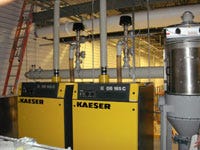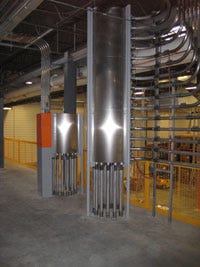German pipe and plumbing giant Viega built efficiency into every aspect of its new manufacturing plant in McPherson, KS from the ground up, including a unique-to-North-America material handling system supplied by Motan.
July 17, 2009
German pipe and plumbing giant Viega built efficiency into every aspect of its new manufacturing plant in McPherson, KS from the ground up, including a unique-to-North-America material handling system supplied by Motan.
A ctually, if you count the radiant heating/cooling system integrated into the concrete floors throughout the facility, which uses crosslinked polyethylene (PEX) tubing made by the company, efficiency extends below ground. In a plant where the bathrooms purposely feature blowers instead of paper to dry your hands, it’s all part of the modus operandi. “The energy footprint of this building reflects Viega’s corporate philosophy,” explains Steve Hullet, director of maintenance and facilities for the new 439,000-ft2 manufacturing and distribution center one hour north of Wichita.
|
At this stage, the site includes 12 extrusion lines ranging from 0.25 inch up to 2 inches, with the capability for coextrusion products, room for 26 total lines, and more systems on the way. In addition to North American inventory of its copper and stainless steel pipe and fittings, the plant integrated injection molding operations for its Manabloc product, with 19 machines on site.
Rx for PEX
PEX poses several unique challenges from a material handling standpoint, starting with the fact that it’s delivered in 1400-lb (635 kg) gaylords, instead of bulk railcar or truck quantities. As the largest PEX extruder in North America, Viega clears a fair amount of the material, making it seem like a natural candidate for large on-site silos, but it has accommodated the boxes utilizing a flow rack measuring three gaylords high by 10 wide. As operators remove boxes, a slight slope to the rack and rollers beneath the boxes, propel the next gaylord forward. Also, since PEX has a shelf life, the system is key for first-in first-out inventory. If a gaylord got lost in the shuffle of standard inventory racks, Viega would be looking at almost one ton of wasted pellets.
In front of the flow racks, Viega maintains a resin-staging area, with lines painted on the floor delineating where boxes will go. This ensures the overhead lines that feed Motan’s central-vacuum system can reach each box.
Two pumps 12 lines
Key to the Motan system is the word “central.” Typically, for an operation this size, a processor would install up to 10 pumps, each with their own filter and maintenance issues, to create the vacuum needed to convey resin, whereas in this system, one pump can handle the entire plant. For redundancy’s sake, Viega has actually installed two high-efficiency pumps with two filters.
The vacuum pumps reside on a mezzanine overlooking the resin-staging area, and the system is arranged so that if one goes down, the other automatically switches on and there’s no downtime. One unit alone can supply the vacuum needed for the entire system, but as it operates today, the two pumps switch on and off, maintaining equal loads so there is less wear and tear.
There is room for a third vacuum pump next to the existing two, and as the facility builds to its full capacity, it will be added to maintain redundant systems. “We built a factory here that we can expand into the market as required,” Hullet says. “As needs go up, we can fulfill those needs. If my capacity doubles, I don’t have to do anything but add on.”
Smarter handling
The vacuum pumps keep consistent vacuum on the vacuum headers, so when a receiver calls for material, it draws, and as the system senses a drop in pressure, it increases vacuum to compensate, keeping a specific amount of vacuum on the head. “That way you only use the amount of energy you need to move just the amount of material that is needed,” Hullet explains. “Instead of running wide open, it slows down.” The Motan program also limits the number of receivers that open at one time, with six to eight able to open simultaneously. “It knows which receiver is needed and which one is next in line,” Hullet says.
Also residing on the mezzanine are two of Motan’s Metrolink units—one with five lines that can be expanded, and 16 on the other. If Viega switches pipe color from black to red, Metrolink does so automatically, including the purge cycle. Not only eliminating the time consumption of manual manifold switching, the system removes the chance for human error. At the company’s old operation, 10 lines running would have required 10 separate wands going into one gaylord, With the new design, one box and wand feeds 10 lines. “We just have to make sure the right wand is in the right box,” Hullet says. “The operator doesn’t have to worry about 25 lines.” Mixing base resin, color, and catalyst, the Motan system allows Viega to change products or product mixes without shutting down all extruders. “When we designed the building, we designed for the material flow,” Hullet says. —[email protected]
About the Author(s)
You May Also Like




